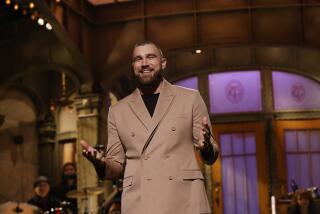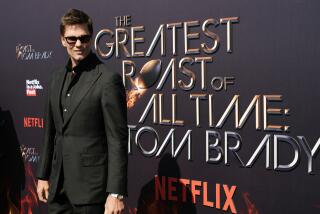Tom Brady’s doctor says knee recovery exceeds expectations
In January, scarcely three months after undergoing a reconstruction of his injured left knee, Tom Brady gave his orthopedic surgeon a gift.
It felt like a present to Dr. Neal ElAttrache, anyway.
Brady summoned him to a Southern California park, and, with the sun setting over the ocean, the New England Patriots quarterback gave his doctor a demonstration of just how far his recuperating knee had come. The 2007 NFL most valuable player performed a brief, light workout, showing he could drop back, roll out, fire passes and was well on his way to recovery.
“When he did that, and all he had to do was look at me with that smile on his face like, ‘Aren’t you happy?’ That meant everything to me,” said ElAttrache, who specializes in sports medicine at the Kerlan-Jobe Orthopaedic Clinic in Los Angeles.
Speaking publicly for the first time about the NFL star’s surgery and physical rehabilitation, ElAttrache told The Times that Brady “even exceeded what I thought he was going to be able to do, and I was expecting big things from him.”
With Brady’s permission, ElAttrache spoke about the knee reconstruction, treatment of a subsequent infection, and the patient’s unwavering focus to recuperate in time to play this season.
“With regard to his recovery of strength, I’ve never seen anything quite like it,” said ElAttrache, who serves as team physician for the Dodgers and worked with the L.A. Rams. “With an average person, it would have taken probably twice as long to get range of motion and strength back.”
Brady, who returned to practice last week for the first time since his injury, was sidelined for the 2008 season after suffering a three-ligament knee injury in the opener against Kansas City.
Instead of staying in Boston to have his surgery, Brady chose to have the reconstruction performed by ElAttrache, an expert and also his friend and occasional golf partner. That decision was scrutinized and criticized, particularly by the media in New England, after details trickled out of a post-operative staph infection that required two follow-up procedures on the knee.
“I remember when we came out of the original procedure and five days later things weren’t going the way that we hoped, and I think it was his instincts and quick decision making that got me in there before anything really bad could happen,” Brady said. “If you misdiagnose something like that, then you have big problems. It was his judgment and instincts, and then him assuring me that everything was going to be OK.
“Obviously, with how I feel now, he was 100% right in what he did. It’s great for me to have so much trust, and to know that, hopefully nothing ever comes up again, but if it does, that I have somebody like him in my corner.”
It wasn’t just the player taking heat for his choice; some questioned the expertise of ElAttrache. But Brady, who owns a home in L.A., where he typically spends much of his free time, said he never doubted the ability or judgment of his doctor.
“Neal was dead on with what he was doing,” the quarterback said in a telephone interview. “I felt he got dragged into a lot of stuff that wasn’t his fault at all. He kept his composure.
“I chose Neal because that was my decision. There are great doctors all over the world, and Neal was right for me. My father always told me tall trees experience high winds, and I think Neal is a person that, when you’re at the top of your profession, you can weather a lot of those storms. I think his true colors really shined through.”
Among the remarkable things about Brady, ElAttrache said, was his interest in knowing every last detail about the surgery and his recovery timeline. The doctor said he eventually had to “loosen the reins and let him go a little bit.”
Said ElAttrache: “Let’s face it, guys that are athletes like him, they’re strung together different. By and large, they follow the same biologic rules as the rest of us. However, they’re able to do things with their neuromuscular control, and their strength gains, and how they respond to exercise a little bit differently. Within safe limits of how we know how these things heal after an operation like this, I had to take that into consideration.”
Even after the infection, Brady said, neither he nor ElAttrache allowed themselves to ponder the possibility of the quarterback sitting out the 2009 season.
“I don’t think either of us ever thought that,” Brady said. “Look, you have a surgery and you have setbacks, you have good days and bad days. That’s part of life, that’s part of the process, so you’ve just got to work through them. When you have a great group of supporters that I have in my friends, my family and certainly Neal, you get through to the next day. You’re always working on getting better.
“I’m never a person that dwells on things that aren’t going well. I just say, ‘OK, it happened. How are we going to deal with it?’ If you’re sitting there focusing on feeling bad for yourself, you’re just wasting a lot of energy on stuff that’s not helping you get better.”
--
Follow Sam Farmer’s NFL coverage on Twitter at twitter.com/latimesfarmer.
More to Read
Go beyond the scoreboard
Get the latest on L.A.'s teams in the daily Sports Report newsletter.
You may occasionally receive promotional content from the Los Angeles Times.











